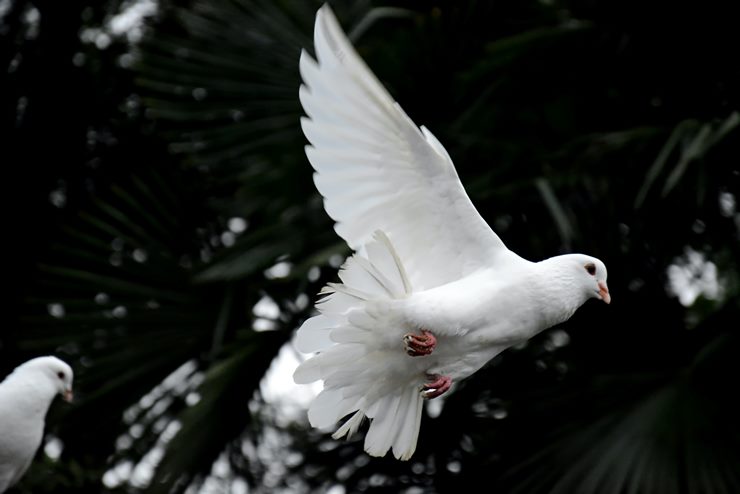A dove is a member of the same family as pigeons, Columbidae. Doves, like pigeons, are common all over the world. The most diverse populations are in Australia, Asia, and Indonesia. These birds are popular game birds worldwide.
Doves often flock together in groups to feed. They eat many different types of seeds, frequently visiting bird feeders and foraging on the ground. These groups of doves are usually called a Bevy.
Additional collective nouns for doves include:
- Cote
- Dole
- Flight
- Piteousness
Many genera of doves containing multiple species exist. Turtle doves consist of several dove species in the genus Streptopelia found in Europe, Asia, and Africa. The collective noun used to describe a group of turtle doves is a Pitying.
One of the most prolific dove species in the Western Hemisphere is the Mourning Dove. These doves make a distinctly sad cooing sound, making them one of the most recognized birds by call. They usually inhabit open areas on forest edges and have adapted well to the suburbs.
Table of Contents

What is a Pair of Doves Called?
Doves are usually monogamous during the breeding season. Sometimes, depending on the species, they breed with the same mate for multiple years until one of them dies. Both parents work together to raise their young.
These dove pairs do not have a specific name. When they court each other, males puff out their feathers, fly around, and coo at the females to attract their attention. Once the dove pair has bonded, they construct a simple nest within two days.
While doves feed on the ground, they generally do not nest on the ground. Instead, they build a nest in shrubs, small trees, window boxes, ledges, and other low places. These nests of twigs, grass, and pine needles are weak, only loosely held together.
Doves can raise several broods each year. Their nests do not hold up to high winds, which can cause nest failure. In addition, if the dove pair feels threatened by humans, cats, or other predators, they will abandon their nest, eggs, or chicks and start another nest someplace else.
What is a Group of Baby Doves Called?
In each nest that doves build, they often lay only two eggs. The female and male take turns incubating these eggs until the chicks hatch after two weeks.
These baby doves are called Squabs. Groups of squabs do not have a specific name.
Once the chicks hatch, parents continue incubating them for a few more days until they can regulate their body temperatures themselves. Dove parents care for their young for a couple of weeks. Doves, like pigeons, produce a milk-like substance in their crop that they feed to their chicks.
Baby doves are old enough to leave the nest twelve days after hatching. The parents stop feeding their babies around that time, forcing babies to fledge and find their own food. Fledgling birds stay on the ground for several days before they fly back into a tree.
Baby doves are most vulnerable right after fledging because they cannot fly away to escape predators. Cats and dogs are the most dangerous predators during this precarious time. Parents may continue to feed them for a few more days after they are on the ground.
Do Doves Flock Together in Groups?
Doves usually feed together in flocks on the ground. Sometimes, mourning doves sit together in groups on trees or telephone wires. These birds may flock together for protection from predators since there is safety in groups with more individuals.
Changes to the landscape are affecting dove populations. Populations are in decline, primarily in areas where people cut down forests and farm agricultural lands as a monoculture. The lack of diversity in plants decreases the availability of food and nesting sites for doves.
Doves only eat seeds and require an abundant supply to maintain their population levels. These birds can stockpile the seeds they eat in their crop and digest them later. They also ingest small pieces of rock to help grind up the seeds they store in their crop.
Do Doves Migrate?
Doves flock together to migrate when the weather changes in the northern parts of their range. In the Americas, doves that live in southern Canada and the northern United States migrate south to Mexico.
Doves living in the southern United States or Mexico may make small, partial migrations or not migrate at all. Once spring arrives, northerly residents fly back to their breeding grounds to construct nests and raise their broods.
Introduced species of European Collared Doves and Rock Doves have become naturalized in the Americas. Rock Doves are white doves released for events like weddings. Both introduced species are considered pests in North America and carry diseases like West Nile Virus.
Researchers have studied the effects of these naturalized populations and concluded that these species fill the same ecological niche as native dove species like the Mourning Dove. Native and introduced doves often compete for nest locations and food resources.
In some instances, scientists believe these introduced doves may be interbreeding with native North American doves, producing hybrid offspring. Evidence suggests that while this interbreeding does occur, it is rare.
Also Read: What is a Group of Pigeons Called
